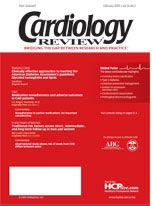Arterial elasticity improved with antihypertensive plus lipid-lowering treatment
Lipid Disorders
San Francisco—Elasticity of the small arteries is improved more with coadministration of amlodipine (Norvasc) and atorvastatin (Lipitor) compared with either treatment alone, said Jay N. Cohn, MD, at the 20th Annual Scientific Meeting of the American Society of Hypertension. The improvement may explain the better cardiovascular outcomes associated with the combination compared with either drug alone.
Reduced arterial compliance is characteristic of hypertension and dyslipidemia. Small artery compliance is reduced in the presence of endothelial dysfunction, said Dr. Cohn, a professor of medicine in the cardiovascular division at the University of Minnesota Medical School. “We know that endothelial dysfunction is a very important contributor to morbid events occurring,” he said.
Premature loss of arterial elasticity predicts the risk of developing cardiovascular disease.
The additive effect of amlodipine and atorvastatin on small artery compliance may account for their superiority in reducing the incidence of vascular events in the Anglo-Scandinavian Cardiac Outcomes Trial (ASCOT), said Dr. Cohn. In ASCOT, which was conducted in 19,257 patients with hypertension, the treatment arm that was assigned to both amlodi-pine and atorvastatin experienced fewer cardiovascular events than the arm assigned to amlodipine alone. Amlodipine had a more favorable effect on cardiovascular events than a comparator beta blocker antihypertensive regimen.
In the Atorvastatin and Amlodipine in Patients With Elevated Lipids and Hypertension (AVALON) Arterial Wall Compliance (AWC) trial (a substudy of ASCOT), 667 patients with hypertension and low-density lipoprotein (LDL) cholesterol of 100 to 250 mg/dL had measurements of vascular compliance at baseline, 8 weeks, and 28 weeks in response to 8 weeks of double-blind treatment with placebo; amlodi-pine, 5 mg/day; atorvastatin, 10 mg/day; or the two drugs coadministered. The mean age of the patients was 56 years.
Small artery elasticity improved by 2.2% from baseline to 8 weeks with atorvastatin alone, by 11.6% with amlodipine alone, and by 19.6% with the combination. Patients who were assigned to placebo had a 2.1% decline in small artery compliance.
“When you put together a calcium antagonist and a statin, you get a dramatic improvement in endothelial function, which in fact may account for why these drugs have a favorable effect on outcomes,” he said. “Since they are more than additive…the effect on endothelial function appears to be a direct consequence of these drugs and their working through separate mechanisms.”
Coadministration of amlodipine and atorvastatin produced sustained improvement in small artery elasticity through 28 weeks, said Dr. Cohn.
Small artery compliance is an assessment of nitric oxide release and its bioactivity while the patient is at rest. Arterial stiffness with age is partly the result of less nitric oxide release.
The arterial elasticity test is completed in 5 minutes; it uses a blood pressure cuff placed on the patient’s upper left arm and an arterial pulse wave sensor on the right wrist overlying the radial artery. Interpretation of the results takes less than 1 minute. (The device was invented by Dr. Cohn.)
Measuring small artery elasticity is a potential tool to track the effects of therapy, he said. “You don’t wait for people to die to find out whether you’re having a favorable effect on the course of their disease,” he said. “It’s above and beyond blood pressure measurement and above and beyond LDL cholesterol measurement; it is a direct measurement of what’s happening in the arterial wall.”
